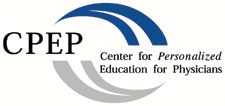Roadmap to reentry
Resource supports clinicians seeking to return to practice after extended absence

Elizabeth J. Korinek, MPH
Chief Executive Officer, CPEP
With the implementation of the Affordable Care Act (ACA) and the need for additional primary care providers, now more than ever it is critical to identify innovative, cost-effective and timely pathways to address primary care workforce shortages. Health care practitioners returning to practice have the potential to be an important part of the solution to the workforce shortage; however, significant barriers exist that discourage providers from returning to practice or cause significant delays in returning. A new resource developed by the Center for Personalized Education for Physicians (CPEP) and the Physician Reentry into the Workforce Project provides guidance for returning clinicians and the entities that employ them, establishing a safe, more efficient return to clinical practice.
Health care is multifaceted and involves many stakeholders, all with their own set of rules and regulations. As a result, reentry to practice can be a complex and daunting process for clinicians who must fulfill a multitude of requirements from a variety of entities. Physician reentry, as defined by the American Academy of Pediatrics’ Physician Reentry into the Workforce Project, is returning to professional activity/clinical practice for which one has been trained, certified or licensed after an extended period of time. It is separate and distinct from remediation, although there are some traits common to both groups.
These clinicians have the potential to be an important part of the solution to workforce shortages, but often are discouraged by the complexity of the current system. The roadmap helps overcome these barriers to reentry by identifying solutions, and providing clear guidance to physicians and physician assistants wanting to return to practice.
The comprehensive 37-page booklet was developed through a series of facilitated meetings funded by the Colorado Trust’s Convening for Colorado program. To maximize the efficiency of the Convening sessions, participants were provided with pre-meeting information so they would have a common understanding of reentry barriers. The two in-depth meetings attracted key leaders from state government, health plans, hospitals and hospital systems, rural and safety net provider groups, associations and not-for-profit organizations, medical defense insurers, medical educators, and private corporations. Rather than communicate with these organizations (or sectors) in silos, bringing stakeholders together provided an opportunity to foster collaboration, and determine common requirements and shared solutions. Approaches agreed upon by stakeholder participants were collected and distilled into one comprehensive resource now available publicly for providers in Colorado and across the nation.
“Although many of the resources and contact information are specific to the state of Colorado, overall, the roadmap is widely applicable beyond the state and for physicians and physician assistants in all specialties,” said Holly J. Mulvey, MA, co-director of the Physician Reentry into the Workforce Project.
This first-of-its-kind resource includes Information on important topics including the following.
- Licensure and board certification
- The reentry plan: Options for reentry clinicians
- Preceptorships
- Hospital credentialing and privileging
- Health plan contracting and credentialing
- Liability and risk management
- Cost of reentry
- Ways to make the reentry experience positive
To access the “Roadmap to Reentry” free of charge, visit www.roadmaptoreentry.org or www.physicianreentry.org.
Posted in: Colorado Medicine

Comments
Please sign in to view or post comments.